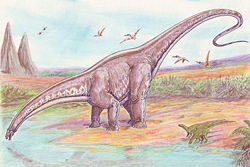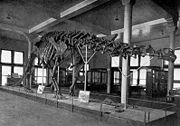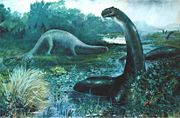Apatosaurus
2008/9 Schools Wikipedia Selection. Related subjects: Dinosaurs
| Apatosaurus Fossil range: Late Jurassic |
||||||||||||||||
|---|---|---|---|---|---|---|---|---|---|---|---|---|---|---|---|---|
 |
||||||||||||||||
| Scientific classification | ||||||||||||||||
|
||||||||||||||||
| Species | ||||||||||||||||
|
||||||||||||||||
| Synonyms | ||||||||||||||||
|
Apatosaurus (IPA: /əˌpætəˈsɔrəs/), formerly known as Brontosaurus, is a genus of sauropod dinosaur that lived about 150 million years ago, during the Jurassic Period ( Kimmeridgian and Tithonian ages). It was one of the largest land animals that ever existed, with an average length of 23 meters (75 ft) and a mass of at least 23 metric tons (25 short tons). The name Apatosaurus means 'deceptive lizard', so-given because the chevron bones were similar to those of a prehistoric marine lizard, Mosasaurus. The name Apatosaurus comes from the Greek ἀπατέλος or ἀπατέλιος meaning 'deceptive' and σαῦρος meaning 'lizard'.
The cervical vertebrae were less elongated and more heavily constructed than those of Diplodocus and the bones of the leg were much stockier (despite being longer), implying a more robust animal. The tail was held above the ground during normal locomotion. Like most sauropods, Apatosaurus had only a single large claw on each forelimb, with the first three toes on the hind limb possessing claws.
Fossils of this animal have been found in Nine Mile Quarry and Bone Cabin Quarry in Wyoming and at sites in Colorado, Oklahoma and Utah, USA.
Classification and species
Apatosaurus is a member of the family Diplodocidae, which also includes close relatives like Diplodocus and Barosaurus, although it is not as closely related to these genera as they are to each other, and hence Apatosaurus is usually placed in its own subfamily, Apatosaurinae, along with its closest relatives Supersaurus and Eobrontosaurus.
In 1877, Othniel Charles Marsh published the name of the type species Apatosaurus ajax. He followed this in 1879 with a description of another, more complete specimen, which he thought represented a new genus and named Brontosaurus excelsus. In 1903, Elmer Riggs pointed out it that Brontosaurus excelsus was in fact so similar to Apatosaurus ajax that it belonged in the same genus, and which Riggs re-classified as Apatosaurus excelsus. According to the rules of the ICZN (which governs the scientific names of animals), the name Apatosaurus, having been published first, had priority as the official name; Brontosaurus was a junior synonym and therefore discarded from formal use.
- A. ajax is the type species of the genus, and was named by the paleontologist Othniel Charles Marsh in 1877 after Ajax, the hero from Greek mythology. It is the holotype for the genus and two partial skeletons have been found, including part of a skull.
- A. excelsus (originally Brontosaurus) was named by Marsh in 1879. It is known from six partial skeletons, including part of a skull, which have been found in the United States, in Colorado, Oklahoma, Utah, and Wyoming.
- A. louisae was named by William Holland in 1915 in honour of Mrs. Louise Carnegie, wife of Andrew Carnegie who funded field research to find complete dinosaur skeletons in the American West. A. louisae is known from one partial skeleton which was found in Colorado in the United States.
Robert T. Bakker made A. yahnahpin the type species of a new genus, Eobrontosaurus in 1998, so it is now properly Eobrontosaurus yahnahpin. It was named by Filla, James and Redman in 1994. One partial skeleton has been found in Wyoming.
History
Othniel Charles Marsh, a Professor of Paleontology at Yale University, described and named an incomplete (and juvenile) skeleton of Apatosaurus ajax in 1877. Two years later, Marsh announced the discovery of a larger and more complete specimen at Como Bluff Wyoming — which, because of discrepancies including the size difference, Marsh incorrectly identified as belonging to an entirely new genus and species. He dubbed the new species Brontosaurus excelsus, meaning "thunder lizard", from the Greek brontē/βροντη meaning 'thunder' and sauros/σαυρος meaning 'lizard', and from the Latin excelsus, "to exceed in number", referring to the greater number of sacral vertebrae than in any other genus of sauropod known at the time.
The finds — the largest dinosaur ever discovered at the time and nearly complete, lacking only a head, feet, and portions of the tail — were then prepared for what was to be the first ever mounted display of a sauropod skeleton, at Yale's Peabody Museum of Natural History in 1905. The missing bones were created using known pieces from close relatives of Brontosaurus. Sauropod feet that were discovered at the same quarry were added, as well as a tail fashioned to appear as Marsh believed it should, as well as a composite model of what he felt was the skull of this massive creature might look like. This was not a delicate Diplodocus-style skull (which would later turn out to be more accurate), but was composed of "the biggest, thickest, strongest skull bones, lower jaws and tooth crowns from three different quarries", primarily those of Camarasaurus, the only other sauropod for which good skull material was known at the time. This method of reconstructing incomplete skeletons based on the more complete remains of related dinosaurs continues in museum mounts and life restorations to this day.
Despite the much-publicized debut of the mounted skeleton, which cemented the name Brontosaurus in the public consciousness, Elmer Riggs had published a paper in the 1903 edition of Geological Series of the Field Columbian Museum which argued that Brontosaurus was not different enough from Apatosaurus to warrant its own genus, and created the combination Apatosaurus excelsus:
- ...In view of these facts the two genera may be regarded as synonymous. As the term "Apatosaurus" has priority, "Brontosaurus" will be regarded as a synonym.
Despite this, at least one paleontologist — Robert Bakker — argued in the 1990s that A. ajax and A. excelsus are in fact sufficiently distinct that the latter continues to merit a separate genus. This idea has not been accepted by many paleontologists.
Paleobiology
Early on, it was believed that Apatosaurus was too massive to support its own weight on dry land, so it was theorized that the sauropod must have lived partly submerged in water, perhaps in a swamp. Recent findings do not support this. In fact, like its relative Diplodocus, Apatosaurus was a grazing animal with a very long neck and a long tail that served as a counterweight. Fossilized footprints indicate that it probably lived in herds.
In 2008, footprints of juvenile Apatosaurus were reported from a quarry in Colorado. These footprints show that juveniles could run on their hind legs in a manner similar to that of the modern basilisk lizard.
Physiology
With such a large body mass, combined with a long neck, physiologists encounter problems determining how these animals managed to breathe.
Beginning with the assumption that Apatosaurus, like crocodilians, did not have a diaphragm, the dead-space volume (the amount of unused air remaining in the mouth, trachea and air tubes after each breath) has been estimated at about 184 liters for a 30 ton specimen.
Its tidal volume (the amount of air moved in or out during a single breath) has been calculated based on the following respiratory systems:
- 904 liters if avian
- 225 liters if mammalian
- 19 liters if reptilian.
On this basis, its respiratory system could not have been reptilian, as its tidal volume would not have been able to replace its dead-space volume. Likewise, the mammalian system would only provide a fraction of new air on each breath. Therefore, it must have had either a system unknown in the modern world or one like birds, i.e. multiple air sacs and a flow-through lung. Furthermore, an avian system would only need a lung volume of about 600 liters compared to a mammalian requirement of 2,950 liters, which would exceed the available space. The overall thoracic volume of Apatosaurus has been estimated at 1,700 liters allowing for a 500-liter, four-chambered heart (like birds, not three-chambered like reptiles) and a 900-liter lung capacity. That would allow about 300 liters for the necessary tissue. Assuming Apatosaurus had an avian respiratory system and a reptilian resting-metabolism, it would need to consume only about 262 liters (69 gallons) of water per day.
It is not known how Apatosaurs ate enough food to satisfy their enormous bodies. It is likely that they ate constantly, pausing only to cool off, drink or to remove parasites. It is surmised that they slept standing upright. They likely relied on their enormous size and herd behaviour to deter predators.
Tail
An article that appeared in the November 1997 issue of Discover Magazine reported research into the mechanics of Apatosaurus tails by Nathan Myhrvold, a computer scientist from Microsoft. Myhrvold carried out a computer simulation of the tail, which in diplodocids like Apatosaurus was a very long, tapering structure resembling a bullwhip. This computer modeling suggested that sauropods were capable of producing a whip-like cracking sound of over 200 decibels, comparable to the volume of a cannon.
In popular culture
The length of time taken for Marsh's misclassification to be brought to public notice meant that the name Brontosaurus, associated as it was with one of the largest dinosaurs, became so famous that it persisted long after the name had officially been abandoned in scientific use. The terms brontosaurus, brontosaurs, and brontosaurians (no capital 'B'; no italics) are often used to refer generically to any of the sauropod dinosaurs.
As late as 1989, the U.S. Post Office issued four "dinosaur" stamps, Tyrannosaurus, Stegosaurus, "Pteradon" (misspelling of Pteranodon, which is a pterosaur and not a dinosaur) and Brontosaurus. The inclusion of these last two lead to accusations of, among other things, "fostering scientific illiteracy." The Post Office defended itself (in Postal Bulletin 21744) thus:
- Although now recognized by the scientific community as Apatosaurus, the name "Brontosaurus" was used for the stamp because it is more familiar to the general population.
Stephen Jay Gould supported this position in his essay "Bully for Brontosaurus", though he echoed Riggs' original argument that "Brontosaurus" is a synonym for "Apatosaurus". Nevertheless, he noted that the creature has developed and continues to maintain an independent existence in the popular imagination.
Film and television
Since the beginning of film history, Brontosaurus has been depicted in cinema. For example, the 1925 silent movie The Lost World features an epic Willis O'Brien special effects battle between a Brontosaurus and an Allosaurus. The Skull Island of King Kong (1933) features a Brontosaurus, which kills several men (by chomping but not eating them) in the original and involved in a stampede and pile-up in the 2005 remake, known as Brontosaurus baxteri (Baxter's Thunder-Lizard). The Brontosaurus of the 2005 film is noticeably different from Apatosaurus, with a square head, low-hanging tail, and snake-like neck; real Brontosaurs would have longer, stiffer necks and tails and horse-like heads.
The "Age of the Dinosaurs" segment of the Rite of Spring sequence in Fantasia features Brontosaurs. The Land Before Time was series of children's movies with the lead character Littlefoot, the longneck. Dink, the Little Dinosaur was an animated children's television series that stared Dink, the young Brontosaurus.
An intercostal clavicle of a Brontosaurus plays a significant part in the movie Bringing Up Baby (1938), starring Cary Grant and Katharine Hepburn.
British comedy group Monty Python's 1974 season includes a sketch involving a " Miss Anne Elk" whose trivial theory about the Brontosaurus parodied the controversy of the time.
The 1975 comedy film One of Our Dinosaurs is Missing features a Brontosaurus skeleton being stolen from the Natural History Museum (although it is only ever called Brontosaurus once. In the rest of the film, it is simply referred to as the Dinosaur).
The 1985 film Baby: Secret of the Lost Legend involves a baby Brontosaurus.
" Mrs. Doubtfire" features Robin Williams, as Danial Hillard, singing a parody of James Brown's " I Got You (I Feel Good)", "I eat wood" by James Browntosaurus (a plastic toy Brontosaurus).
Fred Flintstone worked a Brontosaurus at Mr. Slate's quarry and ate Brontosaurus burgers whilst hitting the pins with Barney.
Music
- David Bellamy once recorded a song called Brontosaurus Will You Wait For Me?
- Built To Spill refer to a brontosaurus constellation in the song Big Dipper
- The Move's heavy metal track Brontosaurus (1970) was a UK #7 hit
- The Piltdown Men's song Brontosaurus Stomp (1960) was an Australian #10 hit
- The Police address a "Mighty Brontosaurus" in their song Walking in Your Footsteps from the album Synchronicity.
- Prince rhymes the word in his song Dinner With Delores from his album Chaos And Disorder
- Weird Al Yankovic mentions a Brontosaurus in his Song The Bedrock Anthem
Other
Several noted companies, including Sinclair Oil and Bronto Software use a Brontosaurus as their respective logos. A main belt asteroid, 9949 Brontosaurus, was named in honour of the genus.
Children's books often feature Brontosaurus. The Little Blue Brontosaurus (1983) is a children's book from Byron Preiss. Danny and the Dinosaur is a children's book by Sid Hoff.



